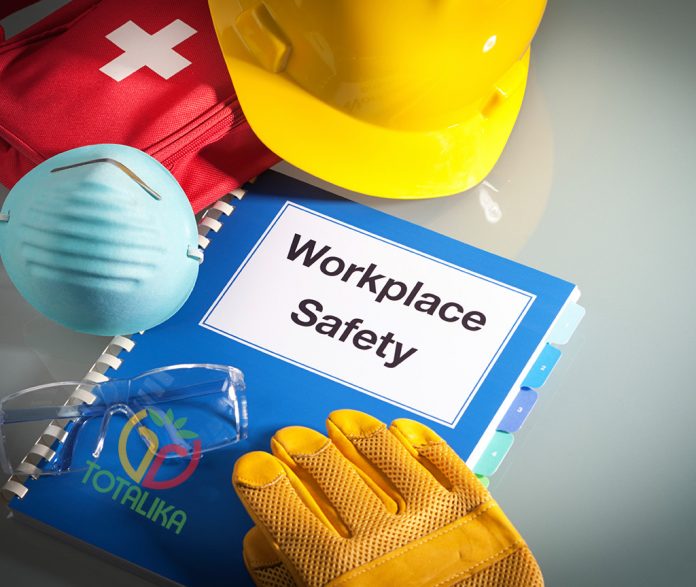Is your workplace a safe one? The question has significant implications for the long-term profitability and survival of any business. That’s because safety affects everyone, from entry-level service personnel to the most tenured members of upper management. Plus, the concept includes much more than just the prevention of accidents. In fact, there are so many components to the making of a secure, safety-friendly workplace that just limiting the list of key items to nine is a bit restrictive.
Managers and owners who want to know more about this all-important topic should do research, attend webinars, take online classes, and do whatever it takes to learn the core skills for keeping safety at the forefront of commercial offices or work spaces of any kind. The following summary is a good beginning, but only a starting point. It’s up to responsible business leaders, owners, and managers to acquire more detailed information on the topic. Fortunately, there are dozens of excellent books, video tutorials, and other resources available in the public domain.
Pay for a Safety Audit

Fortunately, there’s a ready supply of specialty engineers who can do an audit of your company’s premises in order to find potential hazards. These specialists look for things like uneven floors, areas where leakage can create slip and fall zones, activities that can cause fires, faulty equipment that can lead to injuries, and many more. Some smaller and newer organizations often balk at paying a fee for such services. However, viewing the relatively modest expense as an investment is the path toward correct thinking.
Use Fleet Management to Maximize Driver Safety

It’s easy to forget that a workplace can be the inside of a commercial truck. That’s why fleet management systems, like those offered by Samsara, serve as ideal all-in-one programs for enhancing not only driver safety, but also legal compliance, customer service, and vehicle maintenance issues. For businesses who use fleets on a regular basis, it’s essential to know where every vehicle is at any given minute, whether engines are performing properly, how many hours each driver has already logged that day, and much more. A few of the things that can directly impact a driver’s well-being include traffic accidents, mechanical breakdowns, inclement weather, and even something as simple as a flat tire. Fleet management systems are the most effective way to address all these concerns at once.
Require Regular Training
Teaching new hires about the safest ways to behave and how to operate equipment in the proper way is not a one-time task. To create a truly safe environment, it’s essential to conduct ongoing training sessions for employees at all levels of the organization. For instance, many of the world’s most successful corporations conduct weekly safe talks in the form of 15-minute online webinars. There are short, interactive quizzes at the end to make sure everyone pays attention and picks up the key points offered during a session.
Identify Your Most Common Hazards

It’s a good idea to pick a set time each week, often in the afternoon on Thursday or Friday, to walk through the entire office space and simply make note of anything that might present a hazard or danger. Of course, the chore involves more than just note taking. Either fix the situation yourself or assign someone to deal with each identified problem immediately.
Get Everyone Involved
Even in larger organizations where one person has been designated to deal with all issues related to safety, it’s imperative to get everyone involved in the effort. It’s not enough to post signs that say things like, “a safe workplace is everyone’s responsibility.” Mere warnings and reminders don’t get the job done. What does get it done is an active, participatory policy that engages each employee. Some businesses rotate the post of the weekly safety manager within each department or on each floor of a building. The temporary job entails routine identification of common hazards (like spills, jammed stairwell doors, and tattered carpeting) as well as reporting at the end of each day to a designated manager.
Consult with Your Insurance Providers
Your insurance provider is a worthwhile resource for helping identify potentially unsafe situations in a building, complex, or even a small office. Contact your carrier and let them know that you’re putting a company-wise policy in place for preventing accidents, reducing hazards, and eliminating unsafe conditions of all kinds. They’ll often be glad to provide suggestions and other valuable advice about how to achieve your goals.
Keep Detailed Records of Actions and Expenses
No matter how complex or simple your company’s effort is to remove unsafe conditions from the work space, it’s essential to maintain precise records of what you’ve done and what you intend to do. Along with this list, carefully note precise amounts of money spent directly on the tasks. Send a copy of the list to your insurance carrier so they can have it on file in the event an employee or client makes a claim against you.
Consult a Legal Expert
Unsafe situations often lead to legal problems, which can be among the largest single expense category an owner ever encounters. That’s why it’s well worth the cost to hire a legal expert to review your organization’s policies in this vital area. Consider including your insurance company representative in a meeting with a hired lawyer for the sole purpose of discussing potential liabilities.
Don’t Neglect HVAC

It’s common for managers to neglect heating and air conditioning systems when searching for potentially unsafe situations and machinery. But a faulty HVAC component can not only make employees sick, but can lead to long-term illnesses and similar health problems. Most HVAC contractors can perform routine inspections annually or more frequently for larger companies. If you ever suspect there’s something not right about the indoor air, call an HVAC pro immediately to check things out. Don’t try to troubleshoot on your own. Even if you are able to temporarily repair a faulty part, if you’re not a licensed repair professional, you could end up doing more harm than good.









